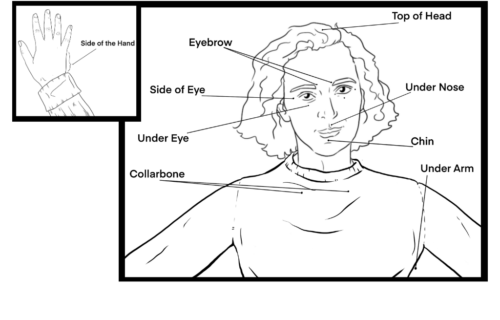
Tapping with Children and Teenagers
WHAT’S THE ISSUE: Tapping with children and teenagers can require putting in a bit more thought in terms of how you can meet them where they are at. How do you keep them engaged? How do you speak their ‘language’? One of the ways I’ve found works quite well when I’m working with children (preschool/PreK to secondary school/high school) as an EFT coach is integrating an Emotion Mat into a tapping session. In this article, I share the 5 Emotion Mats I’ve found most useful when tapping with children via Zoom.
TAPPING WITH CHILDREN AND TEENS
1. THE DOG SCALE OF FEELINGS

This is a Dog Scale of feelings I’ve found is quite popular when I’m tapping with teens of all ages. Particularly if they have a dog, or if they wish they had a dog, as a pet. All you do is share screen on Zoom at the start of the tapping session and ask them 1-9, which one represents how they’re feeling right now, and why.
You them move on how they are feeling on this Dog Scale when they think about whatever it is that they want us to tap on in that session. They might be a 1 because they’re feeling disappointed in themselves for not making better progress on their homework. Or a 5 because they’re annoyed about an History essay they have to write that’s gonna take a long time. Or they’re like a 2 and an 8 because they’re feeling stressed about their upcoming mid-year exams.
Whatever they want to tap on together with me, we can do a ‘before tapping’ and ‘after tapping’ measurement using this dog mat, in addition to the usual 0-10 Subjective Unit of Distress (SUDs) scale that we use to measure progress in EFT sessions. It adds a bit of humour into the mix – something teens often to appreciate.
2. THE PORTRAIT PAIN SCALE

One of the main things I work on with students is reducing psychosomatic pain that is caused by stress and overwhelm. Most of the time it’s stomach aches or headaches. But you can sometimes get chest pain, a feeling of tightness in the through, or pain in the back of the neck that’s above a 5/10 when we start.
All of these manifestations of stuck big emotions in the body can be processed through a teamwork approach with a child that is ready to ‘go there’ and do processing work using a basic EFT Tapping technique called Chase the Pain.
Some of the teens I tap with are really into art and creative stuff. And so they’ve loved this Portrait Pain Scale resources for bringing some humour into the equation and helping whenever I’ve integrated it into a session.
3. THE EMOJI FEELINGS CHART

With the younger students, they really like Emoji Feelings Charts. There are different ones available online, but I found they either had some feelings missing that often came up in sessions, or they had too many and overwhelmed kids. So I created this one bespoke for my tapping with children sessions that has worked well when tapping with children in primary school and the first two years of secondary school.
With the younger students, they really like Emoji Feelings Charts. There are different ones available online, but I found they either had some feelings missing that often came up in sessions, or they had too many and overwhelmed kids. So I created this one bespoke for my tapping with children sessions that has worked well when tapping with children in primary school and the first two years of secondary school.
4. THE WHEEL OF EMOTIONS

Sometimes when you’re tapping with children, particularly when tapping with boys, you may find that their emotional vocabulary is a bit underdeveloped. This is hardly surprising given how often boys and men are been shamed for expressing the more vulnerable human feelings that we all experience, like sadness or fear.
When I was working as a secondary school teacher, it struck me how all through secondary school, you saw this unconscious behavioral pattern that split the genders in stereotypical ways. Girls sitting on the side of the playground talking about how they’re feeling. Boys playing basketball or football and simply giving each other orders and directions.
Is it any wonder that by the end of their school years, the girls would have had more opportunities to develop their social and emotional skills given these culturally engrained – often unconscious – habitual behaviors? So it came as no surprise to me when I found boys who keps sticking to the basic ‘sad’ ‘happy’ emotions were really curious to learn more words. This Wheel of Emotions is particularly intriguing for upper primary and teenage boys, I’ve found.
5. THE MOOD METER

Last but not least, the Mood Meter. I learned about this tool during a conference on Social and Emotional Learning research and practice organized by the European Network of Social and Emotional Learning (ENSEC). I’d gone to deliver an online EFT Tapping for Adult SEL workshop that culminated me leading the group through a tapping for final year exam stress demonstration.
Dr. Brackett was the keynote speaker on the first day of the conference, and I loved how he started the keynote by getting us to write in the chat which of the four zones we were in at the time. So much so that I went on to buy his then newly-released book, Permission to Feel: Unlocking the Power of Our Emotions to Help Our Kids, Ourselves, and Our Society Thrive. And I’ve been a fan ever since.
So that’s how I learned about this additional method of checking in with how my tapping learners are feeling, and I now include this as an option. I have coached one child in Year 5 whose teacher was using this method of checking in with her class during the school day. So some children are already familiar with it.
MORE ON TAPPING WITH STUDENTS
RESEARCH ON TAPPING WITH STUDENTS
Want to read up on the evidence base for the effectiveness of EFT Tapping with children? Check out this bibliography for key research papers and books.
Aremu, A. O., & Taiwo, A. K. (2014). “Reducing Mathematics Anxiety Among Students with Pseudo-Dyscalculia in Ibadan through Numerical Cognition and Emotional Freedom Techniques: Moderating Effect of Mathematics Efficacy.” African Journal for the Psychological Studies of Social Issues, 17(1), 113–129.
Gaesser, A. H., & Karan, O. C. (2017). “A Randomized Controlled Comparison of Emotional Freedom Technique and Cognitive-Behavioral Therapy to Reduce Adolescent Anxiety: A Pilot Study.” Journal of Alternative and Complementary Medicine, 23(2), 102-108. Randomized Controlled Clinical Trial. Doi:10.1089/acm.2015.0316
Gaesser, A. H. (2014). “Interventions to Reduce Anxiety for Gifted Children and Adolescents.” Doctoral Dissertations, 377. Randomized Controlled Clinical Trial. http://digitalcommons.uconn.edu/dissertations/377
Jain, S., & Rubino, A. (2012). “The Effectiveness of Emotional Freedom Techniques (EFT) for Optimal Test Performance: A Randomized Controlled Trial.” Energy Psychology: Theory, Research, & Treatment, 4(2), 13-24. Randomized Controlled Clinical Trial. Doi:10.9769.EPJ. 2012.4.2.SJ
Lambert, M. T., Smith, S. E.; Moss, S., Kirshbaum, M. N. (2022) “Emotional Freedom Techniques (Tapping) to Improve Wellbeing and Reduce Anxiety in Primary Classrooms”, Australian Journal of Teacher Education, 7 (3). https://ro.ecu.edu.au/ajte/vol47/iss3/5/
Sezgin, N., & Özcan, B. (2009). “The Effect of Progressive Muscular Relaxation and Emotional Freedom Techniques on Test Anxiety in High School Students: A Randomized Controlled Trial.” Energy Psychology: Theory, Research, and Treatment, 1(1), 23-30. Randomized Controlled Clinical Trial.
Sezgin, N., Ozcan, B., Church, D., (2009). “The Effect of Two Psychophysiological Techniques (Progressive Muscular Relaxation and Emotional Freedom Techniques) On Test Anxiety in High School Students: A Randomized Blind Controlled Study.” International Journal of Healing and Caring, 9(1). Randomized Controlled Clinical Trial.
Stapleton, P., Mackay, E., Chatwin, H., Murphy, D., Porter, B., Thibault, S. Pidgeon, A. (2017). “Effectiveness of a School-based Emotional Freedom Techniques Intervention for Promoting Student Wellbeing.” Adolescent Psychiatry, 7(2), 112-126. Randomized Controlled Clinical Trial.
Benor, D. J., Ledger, K., Toussaint, L., Hett, G., & Zaccaro, D. (2009). “Pilot study of Emotional Freedom Technique (EFT), Wholistic Hybrid derived from EMDR and EFT (WHEE) and Cognitive Behavioral Therapy (CBT) for treatment of test anxiety in university students” Explore, 5(6). Randomized Controlled Clinical Trial.
Boath, E., Stewart, A., Carryer, A. (2011). “Tapping for Success: A Pilot Study to Explore if Emotional Freedom Techniques (EFT) Can Reduce Anxiety and Enhance Academic Performance in University Students.” Innovative Practice in Higher Education, 1(3).
Boath, E. Stewart, A. Carryer, A. (2013). “Is Emotional Freedom Techniques (EFT) Generalizable? Comparing Effects in Sport Science Students Versus Complementary Therapy Students.” Energy Psychology Journal, 5(2). Doi: 10.9769.EPJ.2013.5.2.EB.AC.AS.SU
Boath E., Good R., Tsaroucha A., Stward T., Pitch Sh., & Boughey A. (2017) “Tapping Your Way to Success: Using Emotional Freedom Techniques (EFT) to Reduce Anxiety and Improve Communication Skills in Social Work Students”, Social Work Education: The International Journal, 715-730, Doi:10.1080/02615479.2017.1297394
Dincer B, Özçelik SK, Özer Z, Bahçecik N. (2022) “Breathing Therapy and Emotional Freedom Techniques on Public Speaking Anxiety in Turkish Nursing Students: A Randomized Controlled Study. Explore (NY). 18(2), 226-233. Doi:10.1016/j.explore.2020.11.006.
Nenden LW, Tukimin S., Dwiagung R., Agus S. (2022) “The Effectiveness of Emotional Freedom Technique on Public Speaking Anxiety in University Students: An Integrated Review”, Open Access Macedonian Journal of Medical Sciences, 10(F):263-268 Doi:10.3889/oamjms.2022.7919
Patterson SL. (2016) “The Effect of Emotional Freedom Technique on Stress and Anxiety in Nursing Students: A Pilot Study”, Nurse Education Today, 40:104-10. Doi: 10.1016/j.nedt.2016.02.003.
Rogers R, Sears SR. (2015) “Emotional Freedom Techniques for Stress in Students: A Randomized Controlled Dismantling Study.” Energy Psychology Theory Res Treatment, 7:26–32. Doi:10.9769/EPJ.2015.11.1.RR
Bach, et al (2019), “Clinical EFT (Emotional Freedom Techniques) Improves Multiple Physiological Markers of Health”, Journal of Evidence-Based Integrative Medicine, Vol 24.
Church, et al (2012) “The Effect of Emotional Freedom Techniques on
Stress Biochemistry: A Randomized Controlled Trial”, The Journal of Nervous and Mental Disease, Vol 200.
Dawson, et al (2018), “Is Tapping on Acupuncture Points an Active Ingredient in Emotional Freedom Techniques? A Systematic Review and Meta-analysis of Comparative Studies”, The Journal of Nervous and Mental Disease, Vol 206.
Stapleton, et al (2020) “Reexamining the Effect of Emotional Freedom
Techniques on Stress Biochemistry: A Randomized Controlled Trial”, Psychological Trauma: Theory, Research, Practice, and Policy.
Maharaj, M. (2016) “Differential Gene Expression after Emotional
Freedom Techniques (EFT) Treatment: A Novel Pilot Protocol for Salivary mRNA Assessment”, Energy Psychology, Vol 8.
Church, et al (2018) “Epigenetic Effects of PTSD Remediation in Veterans using Clinical Emotional Freedom Techniques: A Randomized Controlled Pilot Study”, American Journal of Health Promotion, Vol 32.
Stapleton, et al (2018) “An Initial Investigation of Neural Changes in Overweight Adults with Food Cravings after Emotional Freedom Techniques”, OBM Integrative and Complementary Medicine Journal, Vol 3.
Stapleton, et al (2022) “Neural changes after Emotional Freedom Techniques treatment for chronic pain sufferers”, Journal of Complementary Therapies in Clinical Practice, Vol 49.
Wittfoth, et al (2022) “Bifocal Emotion Regulation Through Acupoint Tapping in Fear of Flying”, Journal of NeuroImage: Clinical, Vol 34 .
Wittfoth, et al (2020) “Emotion Regulation through Bifocal Processing of Fear Inducing and Disgust Inducing Stimuli”, BMC Neuroscience Journal, Vol 21.
Stapleton, P. (2019) The Science Behind EFT: A Proven Stress Management Technique for Mind and Body.
Stapleton, P. (2023) Memory Improvement Through EFT Tapping: A Way to Boost Recall and Clarity.
ABOUT THE AUTHOR

Eleni Vardaki is an experienced teacher and EFT Tapping Coach who specialises in stress, anxiety, and academic success. She works with school and university level students who want to work with her on clearing inner blocks to achieving their personal, career-related, or academic goals. She also runs online and in-person group EFT Tapping sessions for staff, parent, and student well-being.




